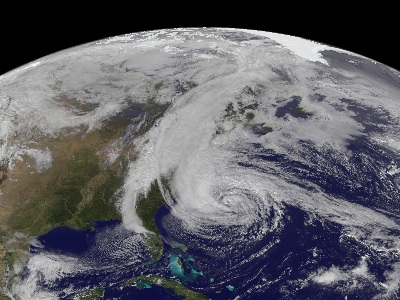An image of Hurricane Sandy taken by the GOES-13 satellite on October 28. This category 1
hurricane was huge, spanning a horizontal distance of about one-third the US continental landmass. The storm came onshore in New Jersey, and gradually moved northeast. The storm disrupted the lives of tens of millions in the eastern US, doing billions of dollars in damage, resulting in over 30 deaths. Visit the National Hurricane Center's webpage on
Hurricane Sandy for details.
Click on image for full size
Image courtesy of NASA
Hurricanes (also known as Tropical Cyclones)
Hurricanes form in the tropics over warm ocean water. The storms die down when they move over land or out of the tropics. At the center of the rotating storm is a small area of calm weather and clear skies called the eye.
Hurricane damage is often caused by flooding from storm surge. Hurricanes have strong waves and wind that cause damage too. And there is often tons of rain. Not all storms are the same. Large and strong storms cause much more damage than small storms. The Saffir-Simpson Hurricane Scale is one way to describe the size of a hurricane.
As a hurricane moves, scientists try to figure out where it will go. They watch hurricanes with weather satellites and use computer models to predict its path. Each hurricane is given a name. Calling the storm by its name helps people spread the word that a storm was on its way.
Hurricanes usually happen at a particular time of year called hurricane season. The timing of hurricane season is different in different regions of the world. In the North Atlantic, hurricane season is from June 1st to November 30th each year.
You might also be interested in:
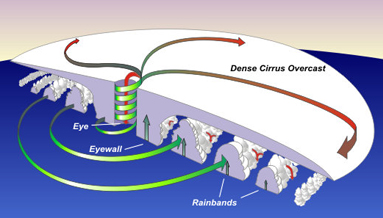
At the center of a fierce tropical storm, there is a small area where the weather is calm, the sky is clear, and the winds are just light breezes. This area is called the eye of the storm. The eye looks
...more
Wind is moving air. Warm air rises, and cool air comes in to take its place. This movement creates the winds around the globe. Winds move at different speeds and have different names based on their speed.
...more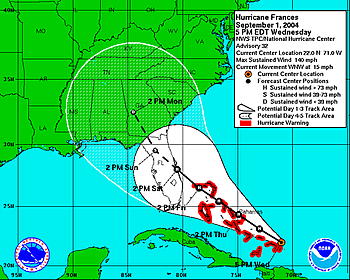
In some years there are many hurricanes. Other years there are only a few. Each year, scientists make predictions about what they think the hurricane season will be like. They can’t say for sure how many
...more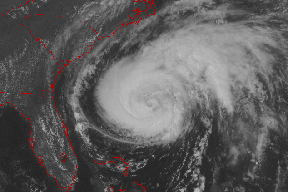
There were a lot of hurricanes in the Atlantic Ocean this year. We usually have six but in 1998 we had ten. Scientists studied four of the ten to find out what makes them move. Scientists looked at the
...more
Below is a list of different weather advisories, watches, and warnings. Severe Thunderstorm Watch: A severe thunderstorm watch is issued when a thunderstorm with strong winds and/or hail the size of a
...more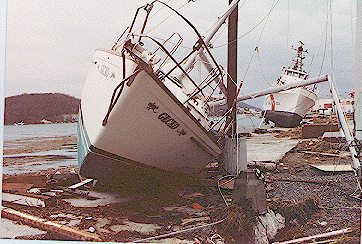
There is a big hurricane called Bonnie out in the Atlantic ocean right now. Hurricanes can cause a lot of damage.From the National Weather Service, Miami, Florida, 11 a.m. EDT: Bonnie battering coastal
...more
This is Administrator Goldin's speech about NASA's 40th birthday: "Forty years ago, in 1958, the National Aeronautics and Space Administration was created with the boldest and most noble of missions: to
...more


